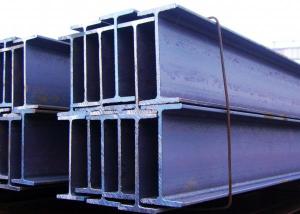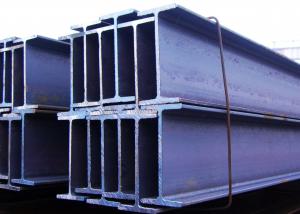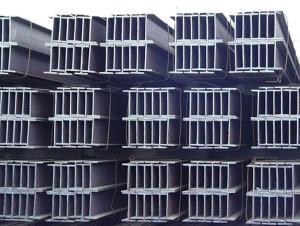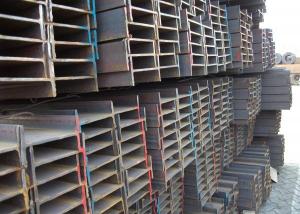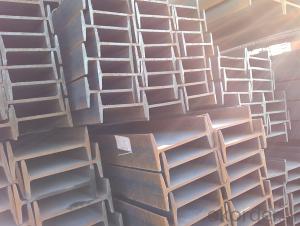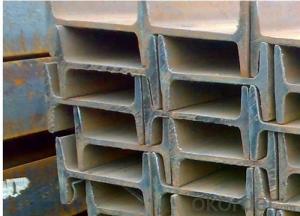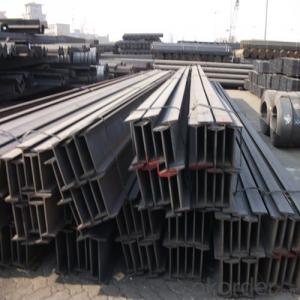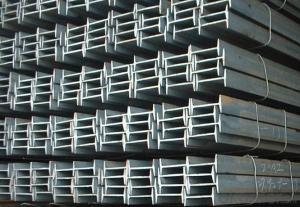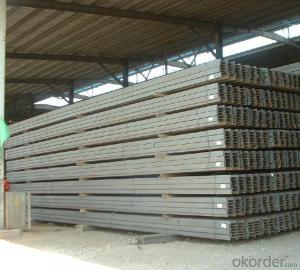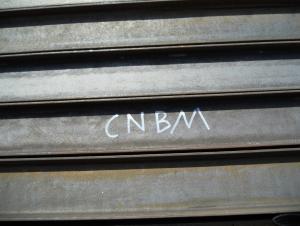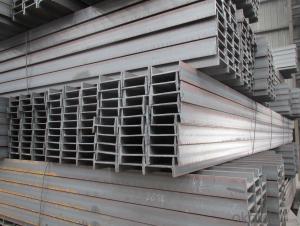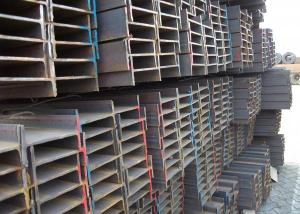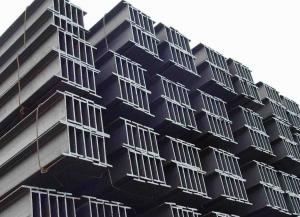I-Beam Steel
- Loading Port:
- Tianjin Port, China
- Payment Terms:
- TT or LC
- Min Order Qty:
- 25MT m.t.
- Supply Capability:
- 10000MT m.t./month
OKorder Service Pledge
OKorder Financial Service
You Might Also Like
Specifications of I-Beam Steel
Product name: I-Beam Steel
Production Standard: GB, BS, ASTM, EN, DIN, JIS
Grade: Q235B, Q345B, ASTM A36, SS400, S235JR, S275JR
Chemical composition
|
Alloy No. |
Grade |
C |
Mn |
S |
P |
Si |
|
Q235 |
B |
0.12%-0.20% |
0.3%-0.7% |
<=0.045% |
<=0.045% |
<=0.3% |
Length: 5.8M, 6M, 8M, 9M, 10M, 12M or as the requirements of the buyer
Sizes: 80MM-270MM
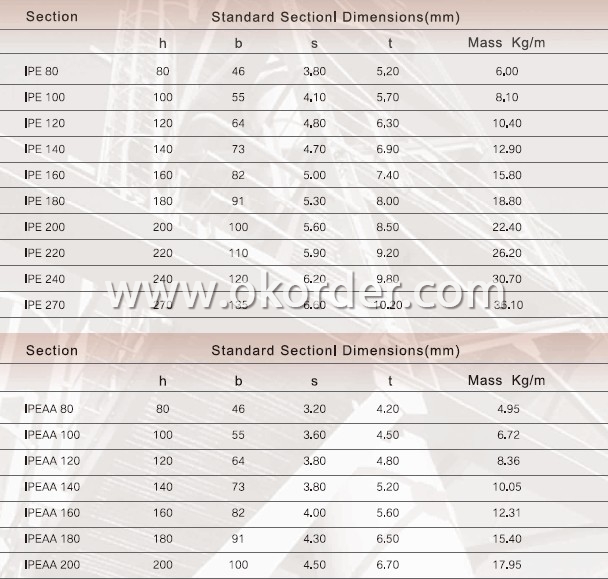
Applications of I-Beam Steel
Widely used in various building structures and engineering structures such as roof beams, bridges, transmission towers, hoisting machinery and transport machinery, ships, industrial furnaces, reaction tower, container frame and warehouse etc.
Package and Delivery
1. Package: All the products will be tired by wire rod in bundles and then put into containers 20', 40' or in bulk cargo.
Or according the requirements of the customers. Each bundle will be hung a CNBM label, which will include the information of our trademark, size, material, lengh, standard, etc. Normally, each bundle contain 50 pieces.
Bundle weight: not more than 3.5MT for bulk vessel; less than 3 MT for container load
But we can also make the bundles as the requriement of you.
2. Delivery: Within 45 days after getting the L/C ORIGINAL or the advance payment by T/T.
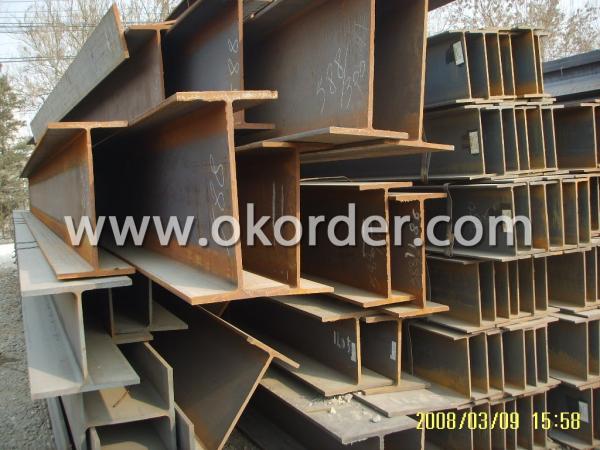
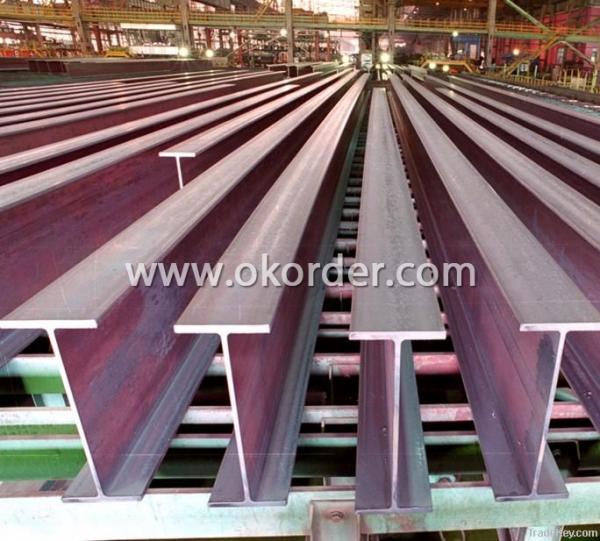
Production flow of I-Beam Steel
Material prepare (billet) —heat up—rough rolling—precision rolling—cooling—packing—storage and transportation
- Q: What is the maximum span for steel I-beams?
- The maximum span for steel I-beams can vary depending on various factors such as the specific type and size of the beam, the load it needs to support, and the local building codes and regulations. However, in general, steel I-beams can have spans ranging from a few feet to over 100 feet.
- Q: Can steel I-beams be custom fabricated?
- Certainly! Steel I-beams can indeed be custom fabricated. Custom fabrication of steel I-beams pertains to the manufacturing procedure of these structural components in accordance with precise design requisites, encompassing distinct measurements, lengths, and load-bearing capacities. This grants the opportunity for tailor-made solutions to address the specific requirements of diverse construction undertakings. The process of custom fabrication of steel I-beams entails cutting, welding, and molding the steel in order to attain the desired specifications. This task is typically executed by seasoned steel fabricators who possess the expertise, aptitude, and apparatus to undertake such ventures. The capability to custom fabricate steel I-beams is of utmost importance in numerous industries, including construction, engineering, and architecture, as it facilitates the establishment of structures that are both secure and efficient.
- Q: Can steel I-beams be used in retail or commercial renovation projects?
- Certainly, steel I-beams are suitable for utilization in retail or commercial renovation ventures. Renowned for their robustness and durability, steel I-beams are an ideal choice for supporting hefty loads and ensuring structural stability. In the context of retail or commercial renovation, these steel I-beams can be employed to establish open and flexible floor plans, bolster mezzanine levels, fortify existing structures, or even erect new structures. Moreover, they can be effectively utilized to construct expansive windows or atriums, as they possess exceptional load-bearing capacities. Furthermore, the fire resistance and resilience to pests and decay exhibited by steel I-beams often render them the preferred option in renovation undertakings. All in all, steel I-beams are extensively favored in retail or commercial renovation projects due to their versatility, strength, and ability to endure the rigors of heavy usage.
- Q: What are the potential drawbacks of using steel I-beams?
- When using steel I-beams in construction projects, there are several possible disadvantages to consider. Firstly, the heaviness of steel as a material can significantly increase the overall weight of the structure. This can result in additional costs for transportation and installation, as well as potential limitations on the building's overall design and load-bearing capacity. Secondly, if steel I-beams are not properly protected, they can be vulnerable to corrosion. Exposure to moisture or harsh environmental conditions can cause rusting, which weakens the beams' structural integrity over time. To prevent this issue, regular maintenance and protective coatings are necessary, which can increase the overall cost and effort required for upkeep. Moreover, steel I-beams have a high thermal conductivity, meaning they can easily transfer heat or cold. This can lead to energy inefficiency as heat or cold passes through the beams, requiring additional insulation measures to maintain comfortable indoor temperatures. These insulation requirements can add to the construction costs and potentially impact the building's overall energy efficiency. Lastly, steel production has a significant environmental impact. The extraction and processing of raw materials for steel production can contribute to deforestation, habitat destruction, and greenhouse gas emissions. Additionally, the manufacturing process itself consumes vast amounts of energy and generates substantial carbon emissions. Therefore, the use of steel I-beams may not align with sustainable building practices and environmental goals. In conclusion, while steel I-beams offer excellent strength and durability, it is important to carefully consider the potential drawbacks related to weight, corrosion, thermal conductivity, and environmental impact before deciding to use them in construction projects.
- Q: Can steel I-beams be used in the construction of shopping malls?
- Yes, steel I-beams can definitely be used in the construction of shopping malls. Steel I-beams are widely used as a structural component in construction due to their strength, durability, and versatility. They are known for their ability to support heavy loads and provide excellent structural stability. In the case of shopping malls, where large open spaces and long spans are common, steel I-beams are particularly suitable. They can be used to create wide, open floor plans and support the weight of multiple floors, as well as provide support for escalators, elevators, and other vertical transportation systems. Additionally, steel I-beams are often chosen for their fire resistance and ability to withstand extreme weather conditions. Overall, steel I-beams are a popular choice in the construction of shopping malls due to their strength, reliability, and flexibility in design.
- Q: What are the standard sizes of steel I-beams?
- The standard sizes of steel I-beams vary depending on the specifications set by different organizations and industry standards. However, there are some common sizes that are widely used in construction and structural engineering. In the United States, the American Institute of Steel Construction (AISC) provides a comprehensive list of standard sizes for steel I-beams. These sizes range from S3x5.7 to S24x121, with various dimensions in terms of depth, flange width, and weight per foot. Another widely recognized standard is the European standard, known as the European I-beam (IPE) sizes. These sizes range from IPE80 to IPE750, with varying dimensions for depth, flange width, and weight per meter. In addition to the American and European standards, other countries may have their own standard sizes for steel I-beams. It is important to consult the relevant national or international standards when selecting the appropriate size for a specific application. It should be noted that these are just a few examples of standard sizes, and the availability of sizes may vary depending on the manufacturer and location. It is always recommended to consult with an engineer or professional in the field to determine the most suitable size for a specific project or design requirement.
- Q: How much is the load-bearing capacity of No. 10 I-beam per metre?
- No problem. Generally, the wardrobe is 550-650 millimeters deep. Two are enough.
- Q: Can steel I-beams be used in renovation projects?
- Yes, steel I-beams can be used in renovation projects. Steel I-beams are commonly used in construction and renovation projects due to their strength and durability. They are often used as load-bearing supports to reinforce existing structures or to create new openings in walls or floors. Steel I-beams can be installed to carry heavy loads and provide structural stability, making them ideal for various renovation applications such as adding additional floors, expanding room sizes, or supporting a new roof. Additionally, steel I-beams are versatile and can be customized to fit specific project requirements, making them a popular choice in renovation projects where structural integrity is crucial.
- Q: How do steel I-beams contribute to sustainable construction?
- Steel I-beams contribute to sustainable construction in several ways: 1. Durability: Steel I-beams are highly durable and can withstand extreme weather conditions, earthquakes, and fire. This longevity reduces the need for frequent repairs or replacements, thereby reducing material waste and resource consumption over the lifespan of a building. 2. Recyclability: Steel is one of the most recyclable materials on the planet. Steel I-beams can be easily recycled at the end of their life cycle without losing their structural integrity. This reduces the demand for new steel production and conserves natural resources, energy, and emissions associated with the mining and manufacturing of virgin materials. 3. Energy efficiency: Steel I-beams can be fabricated off-site in controlled conditions, allowing for accurate sizing and reduced waste during construction. The precise dimensions and lightweight nature of steel also help optimize the design and construction process, resulting in the efficient use of materials and reduced transportation costs. 4. Versatility: Steel I-beams offer design flexibility, allowing architects and engineers to create open, airy spaces with minimal support columns. This versatility not only enhances the aesthetic appeal of a building but also maximizes the use of natural light and ventilation, reducing the need for artificial lighting and HVAC systems. This, in turn, reduces energy consumption and greenhouse gas emissions. 5. Sustainable supply chain: The steel industry has made significant efforts to reduce its environmental impact. Many steel manufacturers have implemented sustainable practices such as using recycled content, minimizing water use, and improving energy efficiency in their production processes. By choosing steel I-beams, builders can support these sustainable practices and contribute to a more sustainable supply chain. Overall, steel I-beams contribute to sustainable construction by providing durable, recyclable, energy-efficient, and versatile building materials. Their use reduces waste, conserves natural resources, and minimizes the environmental impact of the construction industry.
- Q: What are the different aesthetic options available for steel I-beams?
- Steel I-beams offer various aesthetic options to enhance their appearance and seamlessly integrate them into architectural designs. Some popular choices include: 1. Powder coating: Steel I-beams can be powder coated in a wide range of colors and finishes, allowing them to match or complement the surrounding environment or architectural elements. This process not only protects against corrosion but also provides a durable and attractive finish. 2. Galvanization: Galvanizing steel I-beams involves applying a layer of zinc coating to protect against rust and corrosion. This option gives the beams a distinct silver-gray appearance, which can add an industrial or contemporary aesthetic to the overall design. 3. Polishing: Polishing steel I-beams creates a smooth and reflective surface, giving them a sleek and modern look. This option is commonly used in contemporary architectural designs that aim for a high-end, luxurious feel. 4. Brushed finish: A brushed finish involves creating fine lines on the surface of the steel I-beam, providing a unique texture and a more tactile experience. This option is often chosen for designs that seek to incorporate artistic expression. 5. Custom paint or coating: Steel I-beams can be customized with specific paint colors or coatings to match the desired aesthetic. This allows for creativity and personalization, making it ideal for projects with a specific color scheme or branding. It's important to consider that the availability of aesthetic options for steel I-beams may vary depending on the manufacturer, project requirements, and budget limitations. Seeking advice from professionals such as architects, engineers, or steel fabricators can offer valuable insights and recommendations on the best aesthetic options for steel I-beams in a particular project.
1. Manufacturer Overview
| Location | Qinhuangdao, China |
| Year Established | 2000 |
| Annual Output Value | Above US$ 300 Million |
| Main Markets | Mid East; Africa; Southeast Asia; Brazil |
| Company Certifications | ISO 9001:2008; |
2. Manufacturer Certificates
| a) Certification Name | |
| Range | |
| Reference | |
| Validity Period |
3. Manufacturer Capability
| a) Trade Capacity | |
| Nearest Port | Tianjin; |
| Export Percentage | 70% - 80% |
| No.of Employees in Trade Department | 21-50 People |
| Language Spoken: | English; Chinese; |
| b) Factory Information | |
| Factory Size: | Above 400,000 square meters |
| No. of Production Lines | 2 |
| Contract Manufacturing | OEM Service Offered; |
| Product Price Range | Average |
Send your message to us
I-Beam Steel
- Loading Port:
- Tianjin Port, China
- Payment Terms:
- TT or LC
- Min Order Qty:
- 25MT m.t.
- Supply Capability:
- 10000MT m.t./month
OKorder Service Pledge
OKorder Financial Service
Similar products
Hot products
Hot Searches
Related keywords
